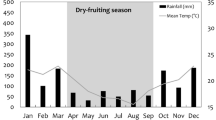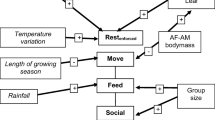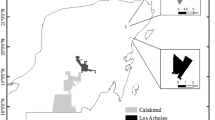Abstract
An animal can only survive in a given habitat if it has enough time to find, process and digest food whilst avoiding predation. The time it has for food acquisition is affected by the vegetation and competition with conspecifics, which depends on aggregation tendencies. We used the relationships between time allocations, on the one hand, and climatic variables (as a proxy for habitat quality) and group size, on the other, to develop a model that predicts maximum ecologically tolerable group size at different locations for spider monkeys. Spider monkeys are particularly interesting because the social communities often split up into small units. Temperature variation and rainfall variation were the main determinants of time budgets. Community size and average annual rainfall determined party size. The model correctly predicted presence or absence of spider monkeys at 78–83% of 217 New World forest sites. Within the geographical range of the species, this time budget model predicted the presence of spider monkeys better than a model based directly on climate variables. Predicted community and party sizes were significantly larger at sites where spider monkeys are present than at sites where they are absent. As required by the model, predicted maximum community sizes were significantly larger than observed community sizes. Moving time showed a U-shaped relationship with party size, which suggests that moving time is the factor that keeps spider monkey communities from travelling together in a tight group.






Similar content being viewed by others
References
Bronikowski AM, Altmann J (1996) Foraging in a variable environment: weather patterns and the behavioral ecology of baboons. Behav Ecol Sociobiol 39:11–25
Caraco T (1979) Time budgeting and group-size: theory. Ecology 60:611–617
Castellanos HG (1995) Feeding behaviour of Ateles belzebuth E. Geogroy 1806 (Cebidae; Atelinae) in Tawadu forest southern Venezuela. Ph.D. thesis, University of Exeter, Exeter
Castellanos HG, Chanin P (1996) Seasonal differences in food choice and patch preference of long-haired spider monkeys (Ateles belzebuth). In: MA Norconk, Rosenberger AL, Garber PA (eds) Adaptive radiations of Neotropical primates. Plenum, New York, pp 451–466
Chapman CA (1988a) Patch use and patch depletion by the spider and howling monkeys of Santa Rosa National Park, Costa Rica. Behaviour 105:99–116
Chapman CA (1988b) Patterns of foraging and range use by three species of Neotropical primates. Primates 29:177–194
Chapman CA (1990a) Association patterns of spider monkeys: the influence of ecology and sex on social organization. Behav Ecol Sociobiol 26:409–414
Chapman CA (1990b) Ecological constraints on group size in three species of Neotropical primates. Folia Primatol 55:1–9
Chapman CA, Wrangham RW, Chapman LJ (1995) Ecological constraints on group size: an analysis of spider monkey and chimpanzee subgroups. Behav Ecol Sociobiol 36:59–70
Clutton-Brock TH, Harvey PH (1977) Primate ecology and social organization. J Zool (Lond) 183:1–39
Connor RC, Heithaus MR, Barre LM (2001) Complex social structure, alliance stability and mating access in a bottlenose dolphin ‘super-alliance’. Proc R Soc Lond B 268:263–267
Cross PC, Lloyd-Smith JO, Getz WM (2005) Disentangling association patterns in fission–fusion societies using African buffalo as an example. Anim Behav 69:499–506
Dasilva GL (1993) Postural changes and behavioral thermoregulation in Colobus polykomos: the effect of climate and diet. Afr J Ecol 31:226–241
Dunbar RIM (1991) Functional significance of social grooming in primates. Folia Primatol 57:121–131
Dunbar RIM (1992a) Behavioral ecology of the extinct papionines. J Hum Evol 22:407–421
Dunbar RIM (1992b) A model of the gelada socioecological system. Primates 33:69–83
Dunbar RIM (1992c) Time: a hidden constraint on the behavioural ecology of baboons. Behav Ecol Sociobiol 31:35–49
Dunbar RIM (1993) Socioecology of the extinct theropiths: a modelling approach. In: Jablonski NG (ed) Theropithecus: the rise and fall of a primate genus. Cambridge University Press, Cambridge, pp 465–486
Dunbar RIM (1996) Determinants of group size in primates: a general model. Proc Brit Acad 88:33–57
Dunbar RIM (1998) Impact of global warming on the distribution and survival of the gelada baboon: a modelling approach. Glob Change Biol 4:293–304
Dunbar RIM (2002) Modelling primate behavioral ecology. Int J Primatol 23:785–819
Dunbar RIM, Dunbar P (1988) Maternal time budgets of gelada baboons. Anim Behav 36:970–980
Dunbar RIM, Sharman M (1984) Is social grooming altruistic. Z Tierpsychol 64:163–173
Elgar MA (1989) Predator vigilance and group dize in mammals and birds: a critical teview of the empirical evidence. Biol Rev Cambridge Philosophic Soc 64:13–33
Erasmus BFN, van Jaarsveld AS, Chown SL, Kshatriya M, Wessels KJ (2002) Vulnerability of South African animal taxa to climate change. Glob Change Biol 8:679–693
Fisher DO, Owens IPF (2000) Female home range size and the evolution of social organization in macropod marsupials. J Anim Ecol 69:1083–1098
Gevaerts H (1992) Birth seasons of Cercopithecus, Cercocebus and Colobus in Zaire. Folia Primatol 59:105–113
Harvey PH, Clutton-Brock TH (1981) Primate home-range size and metabolic needs. Behav Ecol Sociobiol 8:151–155
Henzi SP, Lycett JE, Piper SE (1997) Fission and troop size in a mountain baboon population. Anim Behav 53:525–535
Hill RA, Dunbar RIM (2002) Climatic determinants of diet and foraging behaviour in baboons. Evol Ecol 16:579–593
Hill RA, Lycett JE, Dunbar RIM (2000) Ecological and social determinants of birth intervals in baboons. Behav Ecol 11:560–564
Hirsch A, Dias LG, Martins LdO, Campos RF, Landau EC, Resende NAT (2002) BDGEOPRIM—database of geo-referenced localities of Neotropical primates. Neotrop Primates 10:79–84 (http://www.icb.ufmg.br/~primatas/home_bdgeoprim.htm)
Holekamp KE, Cooper SM, Katona CI, Berry NA, Frank LG, Smale L (1997) Patterns of association among female spotted hyenas (Crocuta crocuta). J Mammal 78:55–64
Isbell LA (1991) Contest and scramble competition: patterns of female aggression and ranging behaviour among primates. Behav Ecol 2:143–155
Isbell LA, Pruetz JD, Young TP (1998) Movements of vervets (Cercopithecus aethiops) and patas monkeys (Erythrocebus patas) as estimators of food resource size, density, and distribution. Behav Ecol Sociobiol 42:123–133
Janson CH, Goldsmith ML (1995) Predicting group size in primates: foraging costs and predation risks. Behav Ecol 6:326–336
Kay RF, Madden RH, van Schaik C, Higdon D (1997) Primate species richness is determined by plant productivity: implications for conservation. Proc Natl Acad Sci U S A 94:13023–13027
Kerth G, König B (1999) Fission, fusion and nonrandom associations in female Bechstein’s bats (Myotis bechsteinii). Behaviour 136:1187–1202
Klein LL, Klein DB (1977) Feeding behaviour of the Colombian spider monkey. In: Clutton-Brock TH (ed) Primate ecology: studies of feeding and ranging behaviour in lemurs, monkeys and apes. Academic, London, pp 153–180
Le Houérou HN (1984) Rain use efficiency: a unifying concept in arid land ecology. J Arid Environ 7:213–247
Legates DR, Willmott CJ (1990a) Mean seasonal and spatial variability global surface air temperature. Theor Appl Climatol 41:11–21
Legates DR, Willmott CJ (1990b) Mean seasonal and spatial variability in gauge-corrected, global precipitation. Int J Climatol 10:111–127
Lehman SM (2000) Primate community structure in Guyana: a biogeographic analysis. Int J Primatol 21:333–351
Lewis S, Sherratt TN, Hamer KC, Wanless S (2001) Evidence of intra-specific competition for food in a pelagic seabird. Nature 412:816–819
Milton K (1981) Food choice and digestive strategies of 2 sympatric primate species. Am Nat 117:496–505
Milton K (1993) Diet and social organization of a free-ranging spider monkey population: the development of species typical behaviour in absence of adults. In: Pereira M, Fairbanks LA (eds) Juvenile primates. Oxford University Press, Oxford, pp 173–181
Mysterud A, Yoccoz NG, Stenseth NC, Langvatn R (2000) Relationships between sex ratio, climate and density in red deer: the importance of spatial scale. J Anim Ecol 69:959–974
Newton-Fischer NE, Reynolds V, Plumptre AJ (2000) Food supply and chimpanzee (Pan troglodytes schweinfurthii) party size in the Budongo Forest Reserve, Uganda. Int J Primatol 21:613–628
Nunes A (1995) Foraging and ranging patterns in white-bellied spider monkeys. Folia Primatol 65:85–99
Nunes A (1998) Diet and feeding ecology of Ateles belzebuth belzebuth at Maraca Ecological Station, Roraima, Brazil. Folia Primatol 69:61–76
Nunes A, Chapman CA (1997) A re-evaluation of factors influencing the sex ratio of spider monkey populations with new data from Maraca Island, Brazil. Folia Primatol 68:31–33
Post E, Forchhammer MC (2002) Synchronization of animal population dynamics by large-scale climate. Nature 420:168–171
Post E, Peterson RO, Stenseth NC, McLaren BE (1999) Ecosystem consequences of wolf behavioural response to climate. Nature 401:905–907
Pozo Rivera WE (2001) Social behavior and diet of the spider monkey, Ateles belzebuth, in the Yasuni National Park, Ecuador. Neotrop Primates 9:74
Pozo Rivera WE (2004) Agrupación y dieta de Ateles belzebuth belzebuth en el Parque Nacional Yasuní, Ecuador. Anuar Investig Cientif 2:77–102
Pulliam RH (1973) On the advantages of flocking. J Theor Biol 38:419–422
Quenette PY (1990) Functions of vigilance behavior in mammals: a review. Acta Oecol 11:801–818
Ramos-Fernandez G, Ayala-Orozco B (2003) Population size and habitat use of spider monkeys at Punta Laguna, Mexico. In: Marsh LK (ed) Primates in fragments: ecology and conservation. Kluwer Academic/Plenum, New York, pp 191–209
Ramos-Fernandez G, Mateos JL, Miramontes O, Cocho G, Larralde H, Ayala-Orozco B (2004) Levy walk patterns in the foraging movements of spider monkeys (Ateles geoffroyi). Behav Ecol Sociobiol 55:223–230
Rodseth L, Wrangham RW, Harrigan AM, Smuts BB (1991) The human community as a primate society. Curr Anthropol 32:221–254
van Roosmalen MGM (1980) Habitat preferences, diet, feeding strategy and social organization of the black spider monkey (Ateles paniscus paniscus Linnaeus 1758) in Surinam (thesis abstract). Wageningen University, Wageningen
van Schaik CP, van Noordwijk MA, de Boer RJ, den Tonkelaar I (1983) The effects of group size on time budgets and social behaviour in wild long-tailed macaques (Macaca fascicularis). Behav Ecol Sociobiol 13:173–181
Schmitter-Soto JJ, Comin FA, Escobar-Briones E, Herrera-Silveira J, Alcocer J, Suarez-Morales E, Elias-Gutierrez M, Diaz-Arce V, Marin LE, Steinich B (2002) Hydrogeochemical and biological characteristics of cenotes in the Yucatan Peninsula (SE Mexico). Hydrobiologia 467:215
Sergio F (2003) From individual behaviour to population pattern: weather-dependent foraging and breeding performance in black kites. Anim Behav 66:1109–1117
Shimooka Y (2003) Seasonal variation in association patterns of wild spider monkeys Ateles belzebuth belzebuth) at La Macarena, Colombia. Primates 44:83–90
Strier KB (1989) Effects of patch size on feeding associations in muriquis (Brachyteles arachnoides). Folia Primatol 52:70–77
Suarez B, Ackerman DR (2002) Social dominance and reproductive behavior in male rhesus monkeys. Am J Phys Anthropol 35:219–222
Symington MM (1988a) Demography, ranging patterns, and activity budgets of black spider monkeys (Ateles paniscus chamek) in the Manu National Park, Peru. Am J Primatol:45–67
Symington MM (1988b) Food competition and foraging party size in the black spider monkey (Ateles paniscus chamek). Behaviour 105:117–134
Symington MM (1990) Fission-Fusion Social-Organization in Ateles and Pan. Int J Primatol 11:47–61
Tuhkanen S (1980) Climate parameters and indices in plant geography. Acta Phytogeogr Suec 67:9–110
Wallace RB (1998) The behavioural ecology of black spider monkeys in North-eastern Bolivia. Ph.D. thesis, University of Liverpool, Liverpool
Wallace RB (2001) Diurnal activity budgets of black spider monkeys, Ateles chamek, in a southern Amazonian tropical forest. Neotrop Primates 9:101–107
Wallace RB, Painter RLE, Taber AB (1998) Primate diversity, habitat preferences, and population density estimates in Noel Kempff Mercado National Park Santa Cruz Department, Bolivia. Am J Primatol 46:197–211
Williamson DK, Dunbar R (1999) Energetics, time budgets and group size. In: Lee P (ed) Primate socioecology. Cambridge University Press, Cambridge, pp 321–338
Willmott CJ, Feddema JJ (1992) A more rational climatic moisture index. Prof Geogr 44:84–88
Wittemyer G, Douglas-Hamilton I, Getz WM (2005) The socioecology of elephants: analysis of the processes creating multitiered social structures. Anim Behav 69:1357–1371
Wrangham RW, Gittleman JL, Chapman CA (1993) Constraints on group size in primates and carnivores: population density and day-range as assays of exploitation competition. Behav Ecol Sociobiol 32:199–209
Acknowledgements
AHK is funded by a research grant from the Leverhulme Trust; RIMD is supported by a British Academy Research Professorship. We thank Sarah Elton, Russell Hill, Erik Willems and Julia Lehmann for their constructive comments on the analyses and their input in constructing the databases. The manuscript benefited from the constructive comments of two anonymous reviewers and David Watts. We also thank the researchers who provided us with information about their studies. The in-depth analysis we did would not have been possible without the generousness of André Hirsh and his colleagues from the BDGEOPRIM project and of Cort Willmott and Kenji Maatsura from the University of Delaware.
Author information
Authors and Affiliations
Corresponding author
Additional information
Communicated by D. Watts
Rights and permissions
About this article
Cite this article
Korstjens, A.H., Verhoeckx, I.L. & Dunbar, R.I.M. Time as a constraint on group size in spider monkeys. Behav Ecol Sociobiol 60, 683–694 (2006). https://doi.org/10.1007/s00265-006-0212-2
Received:
Revised:
Accepted:
Published:
Issue Date:
DOI: https://doi.org/10.1007/s00265-006-0212-2




